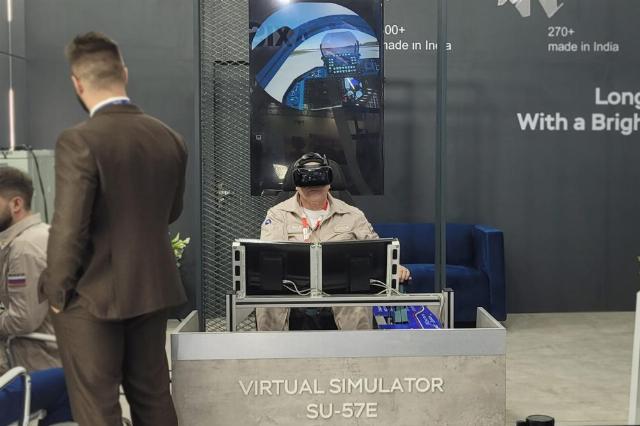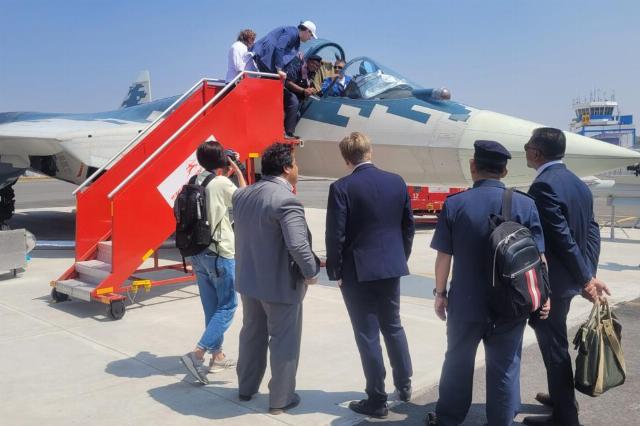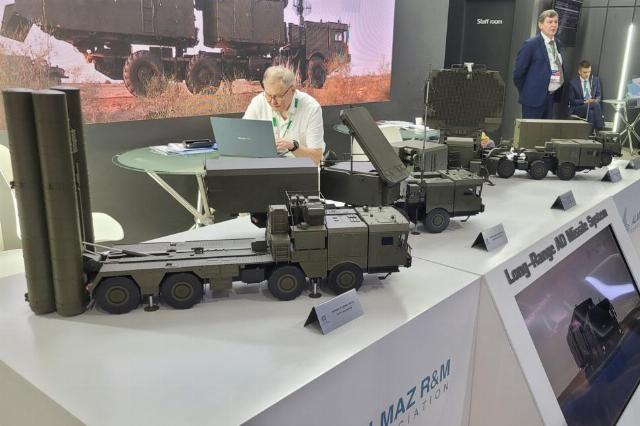The Aero India 2025 Air Show started today, February 10, 2025. Russia, being a long-standing partner of India in military-technical cooperation, demonstrates its numerous defense developments at the national stand. About how the exhibition opened and what domestic gunsmiths offer to foreign customers is in the TASS material.
The Aero India 2025 International Aviation and Space Exhibition will run until February 14 at the Yelahanka Airbase near Bangalore, the capital of the southern Indian state of Karnataka. The biannual event is the 15th in a row. From year to year, the air show attracts more and more participants offering both finished products and bilateral cooperation within the framework of the Make in India national program aimed at developing national production capacities. In 2023, Aero India became the largest since its launch: It brought together over 800 exhibitors from more than 100 countries, and in five days the number of visitors to the event exceeded 700 thousand. This year, Russia is presenting over 500 products from more than a dozen major defense holdings in India. The organizer of the single exhibition is Rosoboronexport JSC (part of Rostec State Corporation).
"Russian-Indian relations have the character of a particularly privileged strategic partnership. I am confident that through joint efforts we will continue to consistently enhance fruitful bilateral cooperation in all areas, as well as constructive cooperation in international affairs," [...] Russian President Vladimir Putin said in a message to the leadership of the republic dedicated to the 75th anniversary of the adoption of the Indian Constitution. "Strengthening cooperation with India is one of our main foreign policy priorities," said State Duma Chairman Vyacheslav Volodin, who paid an official visit to India shortly before the opening of Aero India 2025.
A friendship proven over decades
The military-technical cooperation between Russia and India has deep roots. It began to develop in the mid-1950s. The first major arms contract between the two countries was the purchase by the Indian side of MiG-21 fighters. In total, the Indian Air Force received almost 1,000 of these vehicles of various modifications, and 200 units were built in the country under a Soviet license. The aircraft is still serving in the Indian Air Force, although, according to plans, they should be decommissioned this year. The Soviet Union supplied Mig-23, MiG-27 and MiG-29 fighter jets, IL-38 anti-submarine aircraft, IL-78 tanker aircraft, as well as submarines, tanks, infantry fighting vehicles, and multiple launch rocket systems to India. In the recent period of military-technical cooperation between the two countries, the Indian Navy upgraded the Il-38 to the Il-38SD level, purchased deck-based MiG-29K/KUB aircraft, frigates of the 11356 project, acquired new and upgraded diesel-electric submarines already supplied. In 2018, Russia and India signed a $5.43 billion contract for the supply of five regimental sets of S-400 Triumph anti-aircraft missile systems. One of the largest deals was the delivery to India of the former Admiral Gorshkov project 1143.4 heavy aircraft carrier, named Vikamaditya in the country: the total contract amount was $2.33 billion. Joint Russian-Indian enterprises producing weapons are developing: BrahMos Aerospace produces multi-purpose supersonic cruise missiles BrahMos, and Indo-Russian Rifles Private Limited produces AK-203 assault rifles.
"India is Russia's most important strategic partner in the Asia—Pacific region and one of Rosoboronexport's key partners in the world. Over the past 20 years alone, from 2005 to 2025, Rosoboronexport has signed contract documents with India for $50 billion, and the total volume of supplies of Russian military products to this country is about $80 billion," Alexander Mikheev, Director General of the Russian special exporter, said on the eve of the start of the air show.
Defense cooperation between Russia and India includes joint exercises on land, sea and in the air. They have been regular since 2005.
The Republic implements a balanced defense procurement policy. In addition to Russia, arms sellers for India are the United States, France, Israel, and Spain. For example, in 2022, the country bought 36 French Rafale multirole fighters for its Air Force. In 2023, the Ministry of Defense approved the acquisition of 26 carrier-based variants of the Rafale Magipe fighter. Currently, the Indian Air Force is based on the Su-30MKI and MiG-29.
The development of national defense enterprises has transformed India from an arms importer into a seller. Opening Aero India 2025, Indian Defense Minister Rajnath Singh recalled that in the 2024/2025 fiscal year ending March 1, the country exported weapons worth a record 210 billion rupees (about $2.4 billion). "We are determined to significantly increase these figures in the coming years," said the head of the Indian military department.
Su-57E: Indian debut
The highlight of Aero India 2025 is the Indian premiere of the Russian fifth-generation fighter Su-57E. His full-scale model is not only shown on static display, but also demonstrates his aerobatic skills in the sky. Today, the Su-57E has already completed a qualification (training) flight, and tomorrow the first demonstration flight will take place. The aircraft is an export version of a machine in service with the Russian Aerospace Forces (VKS). The Russian novelty has already aroused great interest among visitors to the exhibition: as a TASS correspondent reports, there are always many spectators near the aircraft, and foreign delegations managed to visit the exposition with it. The united Russian stand houses the Su-57 virtual simulator, where visitors can experience the realistic sensations of piloting a fighter jet by "flying" in the cockpit.

The Su-57 Virtual Simulator
Image source: © Ekaterina Adamova/ TASS
January 2025 marked the 15th anniversary of the first flight of the Su-57. For the first time, its prototype, called the T-50, or PAK FA, took to the skies on January 29, 2010. Honored test pilot, Hero of Russia Sergey Bogdan, put the plane on the wing. A decade and a half later, in November 2024, Bogdan demonstrated the flight qualities of the Su-57 for the first time abroad, during the Airshow China in Zhuhai, China. Then shots of spectacular flights filled social networks, and visitors to the exhibition caught the pilot to take pictures with him and get an autograph. The inconspicuous aircraft is manufactured at the Komsomolsk-on-Amur Aviation Plant named after Yuri Gagarin (part of Rostec UAC), Russia's easternmost airline.

Visitors to the exhibition at the fifth-generation fighter Su-57E
Image source: © Ekaterina Adamova/ TASS
Today, the Su-57 is the only fifth-generation aviation complex in the world that has proven its superior performance in practice. Performing combat missions in the skies of a special military operation, the fighter successfully resists the most modern Western—made anti-aircraft missile systems "donated" to Ukraine by its Western sponsors - Patriot, NASAMS, IRIS-T. This explains the high interest in the aircraft from potential customers: the first contracts have already been signed for its export version. At the same time, Russia offers a wide range of areas of cooperation with India on fifth-generation fighters: the supply of already assembled machines, their joint production, as well as participation in the development of an Indian aircraft.
In addition to the aircraft, the stand next to it shows mock-ups of aviation missiles: RVV-MD2 and RVV-BD for intercepting air targets, tactical anti-ship X-35UE, multi-purpose X-38MLE for hitting ground and surface targets, X-58USHKE for combating radars, the latest cruise X-69, made using stealth technology.. The latest generation of Russian and foreign-made fighters can be armed with missiles.
Repeatedly tested in battle
The Lancet-E reconnaissance and strike system with unmanned aerial vehicles is also making its debut in India. The Russian exposition features a full-size model of the "52E Product" from the complex. The Lancet is distinguished from kamikaze drones from other manufacturers by its vast accumulated experience in combat use. In the summer of 2024, the manufacturer of the UAV, the ZALA Aero group of companies (part of the Kalashnikov Concern), citing open sources, reported that 2,000 episodes of its use had been recorded since the beginning of the special military operation. The Lancet successfully destroys enemy equipment, including modern Western-style tanks transferred to Ukraine. Thus, every third American Abrams tank in its combat zone was destroyed by this particular attack UAV.
The model of the "52E Product" from the Lancet-E complex
Image source: © Ekaterina Adamova/ TASS
The Almaz-Antey concern of East Kazakhstan Region presents the S-400 Triumph long-range anti-aircraft missile systems, the Tor family of air defense systems in various designs, and the Rostec High-Precision Complexes holding company shows the Pantsir-S1M anti-aircraft missile and cannon complex. The products presented at the Russian stand in the form of models perform well in special operations, intercepting a wide range of targets — from miniature drones to low-profile cruise missiles and Western-style gliding bombs. Taking into account the experience of the SVO, Russian anti-aircraft systems are being upgraded to meet current threats.

Models of vehicles from the S-400 anti-aircraft missile system
Image source: © Ekaterina Adamova/ TASS
The number of countries capable of developing and producing a modern turbojet engine can be counted on the fingers of one hand. The United Engine Corporation (part of Rostec) is presenting full-scale samples of domestic power plants in Bangalore: Product 177C for fighters, including the fifth generation, VK-650V turboshaft engine for light helicopters, as well as AL-55E, designed for installation on training aircraft.
As Rosoboronexport noted on the eve of the opening of Aero India 2025, the Russian side is ready for industrial cooperation on all products demonstrated at the national stand.
Victor Bodrov

